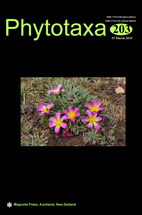Abstract
The wild buckwheat Eriogonum corymbosum is widely distributed throughout the southwestern United States, forming a complex of eight varieties. E. corymbosum var. nilesii is a predominantly yellow-flowered variant reported primarily from Clark Co., Nevada. A previous genetic study by our research group found that var. nilesii is genetically distinct from other E. corymbosum varieties, based on a limited number of populations. Here, we assess genetic variation in 14 newly sampled yellow-flowered populations from southern Nevada, southern Utah, and northern Arizona, and compare them to genetic variation in six populations of previously determined E. corymbosum varieties. Of the new populations, we identified four as var. nilesii, four as var. aureum, three as var. glutinosum, two as apparent hybrids involving vars. aureum and nilesii, and one as a more distantly related admixture involving E. thompsoniae. Our results extend the range and area of E. corymbosum var. nilesii considerably from that traditionally stated in the literature. However, this extended range is confined to the Mojave Desert region of southern Nevada, and the number of known populations remains limited.

